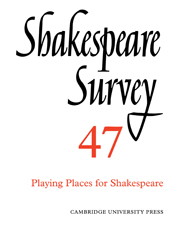Book contents
- Frontmatter
- Shakespeare Played Small: Three Speculations about the Body
- The Architecture of the Fortune Playhouse
- The Bare Island
- ‘How Chances it they Travel?’ Provincial Touring, Playing Places, and the King’s Men
- Writing for the Metropolis: Illegitimate Performances of Shakespeare in Early Nineteenth-Century London
- The Perishable Body of the Unpoetic: A. C. Bradley Performs Othello
- Playing Places for Shakespeare: The Maddermarket Theatre, Norwich
- ‘A Fairly Average Sort of Place’: Shakespeare in Northampton, 1927–1987
- The Living Monument: Self and Stage in the Criticism and Scholarship of M. C. Bradbrook
- Stratford Stages: Interviews with Michael Reardon and Tim Furby, and Sam Mendes
- Dis-Covering the Female Body: Erotic Exploration in Elizabethan Poetry
- Theseus’ Shadows in A Midsummer Night’s Dream
- ‘Time for Such a Word’: Verbal Echoing in Macbeth
- Shakespeare’s Knowledge of Italian
- Tamburline and Edward Alleyn’s Ring
- Shakespeare Performances in England, 1992–1993
- Professional Shakespeare Productions in the British Isles, January-December 1992
- The Year's Contributions to Shakespeare Studies 1 Critical Studies
- 2 Shakespeare’s Life, Times, and Stage
- 3 Editions and Textual Studies
- Books Received
- Index
The Architecture of the Fortune Playhouse
Published online by Cambridge University Press: 28 March 2007
- Frontmatter
- Shakespeare Played Small: Three Speculations about the Body
- The Architecture of the Fortune Playhouse
- The Bare Island
- ‘How Chances it they Travel?’ Provincial Touring, Playing Places, and the King’s Men
- Writing for the Metropolis: Illegitimate Performances of Shakespeare in Early Nineteenth-Century London
- The Perishable Body of the Unpoetic: A. C. Bradley Performs Othello
- Playing Places for Shakespeare: The Maddermarket Theatre, Norwich
- ‘A Fairly Average Sort of Place’: Shakespeare in Northampton, 1927–1987
- The Living Monument: Self and Stage in the Criticism and Scholarship of M. C. Bradbrook
- Stratford Stages: Interviews with Michael Reardon and Tim Furby, and Sam Mendes
- Dis-Covering the Female Body: Erotic Exploration in Elizabethan Poetry
- Theseus’ Shadows in A Midsummer Night’s Dream
- ‘Time for Such a Word’: Verbal Echoing in Macbeth
- Shakespeare’s Knowledge of Italian
- Tamburline and Edward Alleyn’s Ring
- Shakespeare Performances in England, 1992–1993
- Professional Shakespeare Productions in the British Isles, January-December 1992
- The Year's Contributions to Shakespeare Studies 1 Critical Studies
- 2 Shakespeare’s Life, Times, and Stage
- 3 Editions and Textual Studies
- Books Received
- Index
Summary
Edward Alleyn embarked on his Fortune playhouse project late in 1599, soon after the Globe had opened on Bankside. On 22 December he leased a site near Cripplegate, and within three weeks had signed up Peter Street, the Globe's carpenter. Only two years earlier he had quitted the stage to concentrate on business affairs, but short retirement urges sweet return, and already he was planning his comeback, for which the new playhouse was to be the elegant setting. He paid for it himself, and looked for another sort of return from the income generated by its galleries. The Fortune was the player's investment in his own confident talent.
The contract drawn up between Alleyn, his partner Philip Henslowe, and their builder is a tantalizing document, holding back as much information as it offers. To save going into a mass of particulars it cites another building - the Globe - as a defining prototype, a shortcut often found in such agreements, and made especially effective in this case by the carpenter's intimate knowledge of the model. The Fortune was, in untold ways though certainly not in everything, a replication of the 'round' Bankside playhouse.
Yet its plan, the contract tells us, was to be 'sett square', a radical if not altogether surprising departure from the Globe's example. To Alleyn, contemplating the building of a new playhouse during the closing months of 1599, London offered a variety of models. The old public theatre type, perhaps initiated as long ago as 1567 at the Red Lion in Whitechapel, was still the main standard.
- Type
- Chapter
- Information
- Shakespeare Survey , pp. 15 - 28Publisher: Cambridge University PressPrint publication year: 1994
- 2
- Cited by



